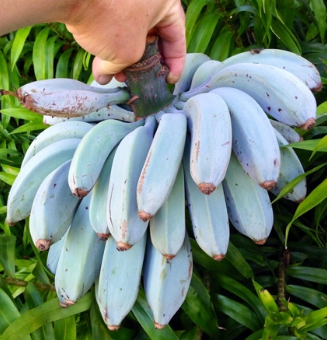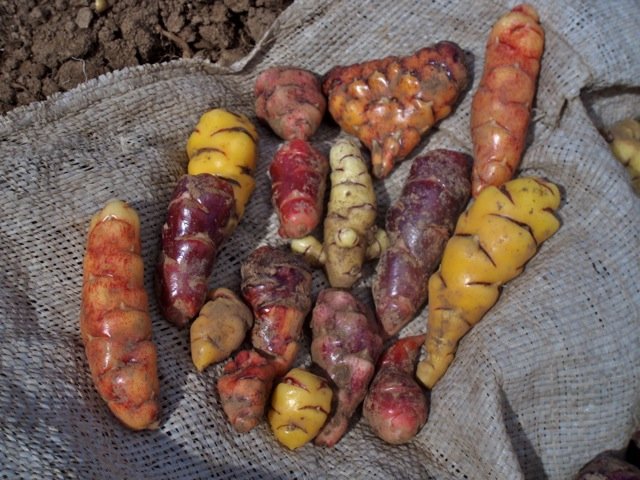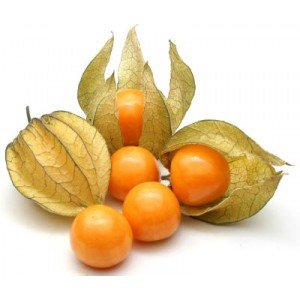Usually I like to post about strange animals but today, I want to share 10 weird fruits & vegetables which I plan to grow next season. Unfortunately, winter is coming in Greece and since I have yet to make a greenhouse I have to wait a few months until next year.
Hopefully, you will find the plants below interesting enough to give them a try yourself too, if you already haven't:
1. Cucamelons

(credit)
I first heard of Cucamelons a few months ago by a Mexican friend of mine. As you can see in the photo, they look like tiny watermelons. Scientifically described as Melothria scabra, this plant is a vine originating from Mexico and Central America, where it is called sandiita which not surprisingly translates to little watermelon.
The grape-sized fruits are edible and taste like cucumbers with a tinge of sourness. I have done some reading on the plant, and it seems that cucamelons are very easy to grow. As long as there is something for them to vine up they are good to go. I think they will do quite well in my garden.
Cucamelons are started from seeds, here's a link to amazon if you want to buy some for cheap. And here's a link to a how to grow guide that covers all the basics you need to know about the plant. Now, to the next plant
2. Ice Cream Banana Tree
So here's a photo of some of my banana trees:

Although I have plenty of them for like 7-8 years now, I haven't eaten a single banana. In case you don't know, bananas need at least 9 months of temperatures above 20 C (68 F) to bear fruits. Unfortunately, this is not the case in Greece.
But it seems like I might have found a solution for my problem. Let me introduce you to the Ice Cream Banana:

(credit)
Apparently, this blue variety grows faster and handles cold better than any other variety. It's also said to be one of the most delicious varieties, with many rating this as the best tasting banana.
Will it be hardy enough to give me fruits in my garden? Don't know yet, and I won't for like the next 2 years. But this time, I also plan to start a few plants in large pots that I will move inside when cold, to "win" a few extra months. Hopefully, I will manage to eat some self-grown bananas in the future :D
3. Romanesco broccoli

(credit)
If you like fractals you will love this broccoli!! Also known as Roman cauliflower, Broccolo Romanesco, Romanesque cauliflower or just Romanesco, this plant appears to originate from Italy where it has been grown since the 16th century.
When I first saw photos of this a couple weeks ago I was like "this can't be true, it has to be photoshoped"! But apparently I couldn't be more wrong, so it's definitely into my to-grow-next-season list. Here's a link to amazon if you want to grow this alien-looking brocolli too!
Since its in the same species as the broccoli and cauliflower, it has the pretty much the same requirements. If you have grown any of the two before, the Romanesco will be no problem for you. When compared to cauliflower, its texture is crunchier, and the flavor is delicate and nutty.
4. Oca

Oca tubers (credit)
Next on my list of weird plants to grow is the Oca, also known as New Zealand Yams. Scientifically described as Oxalis tuberosa, this is a perennial herbaceous plant mainly grown for its tubers, but the leaves are edible too.
The plant originates from central and southern Andes and was introduced in Europe in 1830 and New Zealand sometime in 1860 as an alternative to potato. According to wikipedia, in order to get a good harvest, the plant requires a long growing season, and is day length dependent, forming tubers when the day length shortens in autumn. I have no idea how it will fare in my country's climate, so I have to wait and see next year :)
Like potatoes, the easiest way to start this plant is from a tuber. They are frost susceptible, so better plant them when the danger of frost has passed. Here's a link to amazon to check for any of you that might got interested in this plant.
In case you wonder how it tastes, the short answer is like a “lemony potato” or “potato with sour cream.”.
5. Cape gooseberry

Ripe cape gooseberries, (credit)
Scientifically described as Physalis peruviana, this plant originates from Peru and has been introduced to England and other countries since the late 18th century.
As you can see in the photo above, this is a very unique plant, producing berries inside paper-like lanterns. Since it's a member of the plant family Solanaceae, it is related to tomatoes, potatoes and especially tomatillos. The fruit inside the lantern is a smooth spherical berry, that looks somewhat like a small tomato.

Immature fruit in green calyx (credit)
The two main ways to start a plant is with seeds and cuttings. As for taste, "they are not very sweet; they have a ripe, earthy taste that does indeed remind us just a little of a tomato."
I couldn't find much info on the ideal conditions for growing this plant, so again I don't know how well it grow in my area. Hopefully all will go well. I can't wait to unwrap some out of their little paper latern! :D
The End (For Now!)
So, this post is getting a bit big (at least for steemit standards! ) so I have decided to split it into two parts. I will release the next one in a couple of days so stay tuned if you liked what you saw :)
In the meantime, why don't you throw me some other weird plant suggestions in the comments down below? Maybe my list will grow larger!
Previous Posts
Here are some of my latest posts, I hope you enjoy them:
- How To Hypnotize Your Chicken! & SBD Giveaway
- Gasteracantha: Tiny Spiders From Hell!
- 7 Horrifying Micro-Monsters That Will Haunt Your Dreams
- Greta oto: The Butterfly With The Transparent Wings
- Crickets, Grasshoppers And Other Disgusting Things Are An Excellent Source Of Iron (And Other Minerals!)
 Steemstem & SteemitEducation
Steemstem & SteemitEducation
Steemstem is the go-to place for science on Steemit. Check it out at @steemstem or visit the #steemSTEM channel. A big thank you also goes to the guys from @steemiteducation for supporting my content!
Greek Community
A final big thanks goes to my fellow greeks for their support and love. Follow the greek-trail or check the facebook page for more greek content!

